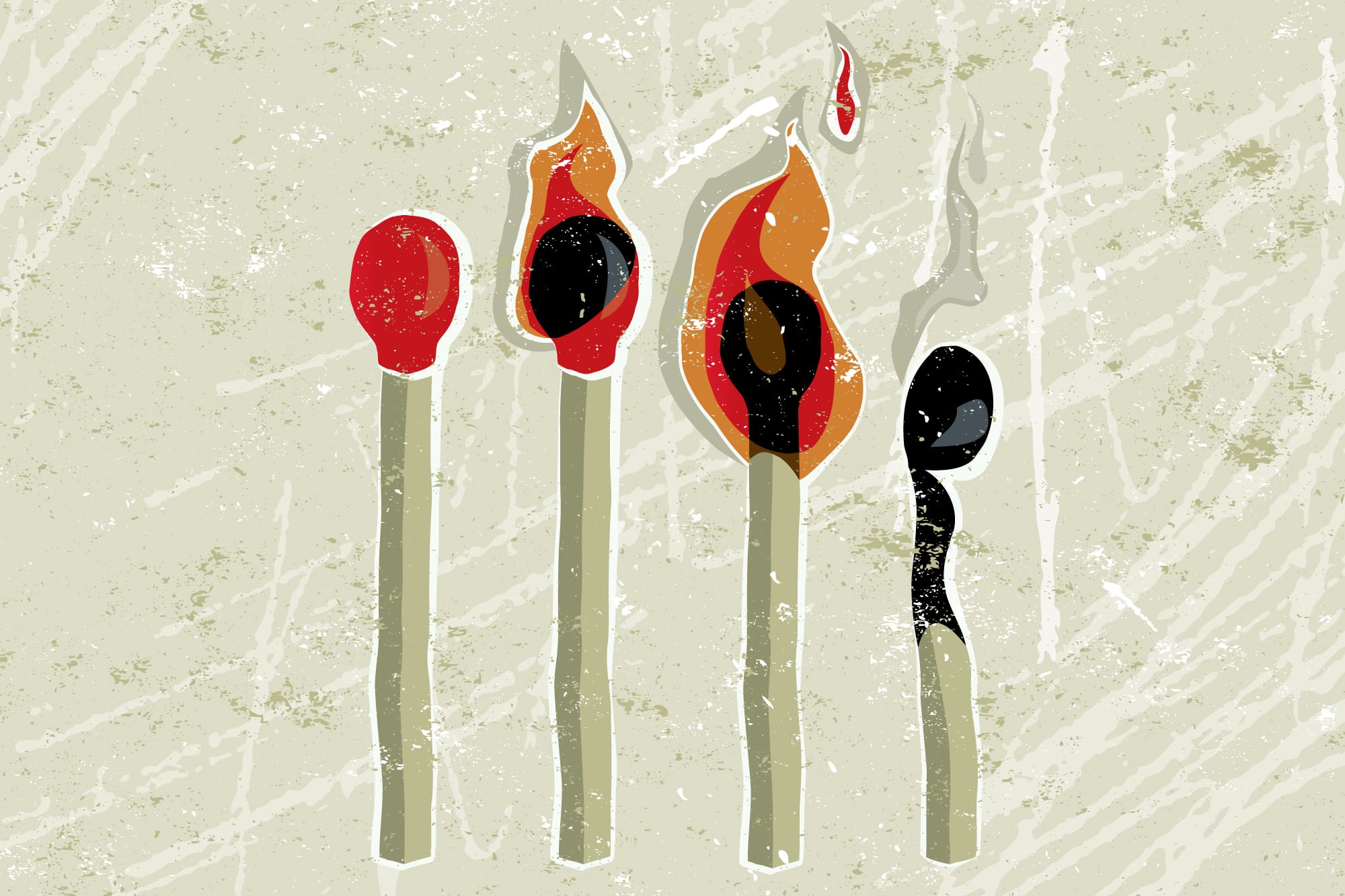Are you headed for burnout? New studies show that chronic workplace stress may be a major cause of burnout.
Earlier this year I was speaking at a conference in the US. All went brilliantly. The talk was interactive, engaging and thought-provoking. The attendance was fantastic. The atmosphere fun, warm and friendly. The praise and thanks afterwards effusive. An all-out success. Two hours later, back in my hotel, I realised I was running on empty. I finally had to accept something was up. I was burnt out. Still functioning, still able to perform at a high level, still appearing to everyone else to be fine. But burnout sneaks up from below or from the side. And it often hits those of us who pride ourselves on having endless energy and stamina. Which makes it hard to accept that our eternal flame might just be flickering to burnout. So, I decided to take a step back, catch my breath, and hand the poll position in the company to my sister Penelope. A hard decision. And the best decision. I hadn’t stopped since the death of my partner Tom in 2016. And it was time to recharge. Why am I writing this? Because when I told my clients I would be taking some time out I think I expected them to be a bit thrown and a bit disappointed and frankly abandoned. But in fact, they were not only supportive but many of them said to me I was modelling something that perhaps they too should think about doing. And they were right. I have coached a number of execs over the years who have pushed themselves to their limits to perform to their maximum. We’re all at it! And perhaps my move to take time out could do more than simply look after myself. Perhaps it could help others do the same for themselves.
Six months on I’m gearing back into work. Keynotes and conferences lined up in the diary, new programmes and pilots rolling out and all of it feeling exciting and welcome. And I’m feeling renewed, re-energised and bursting with creativity and new ideas. Oh and there’s nothing like a mini-sabbatical to give one time to toe-dip into dating again….but that’s another story! Back to burnout and what the hell it’s all about…

An “occupational phenomenon”
The World Health Organisation recently defined burnout as an “occupational phenomenon” caused by “chronic workplace stress that has not been successfully managed.” So, this month we’re reigniting the conversation around burnout and attuning ourselves to its early warning signs. How can we become aware of the often-silent signs and signals of this invisible syndrome? And how can we better manage our workload, so that it doesn’t end up managing us? This isn’t just about getting back in the driver’s seat of your life. It’s about understanding the mechanics underneath so that we can live and work at our optimum. Because knowing when to hit the brakes- and when to take a break- is key to building a satisfying and successful career.
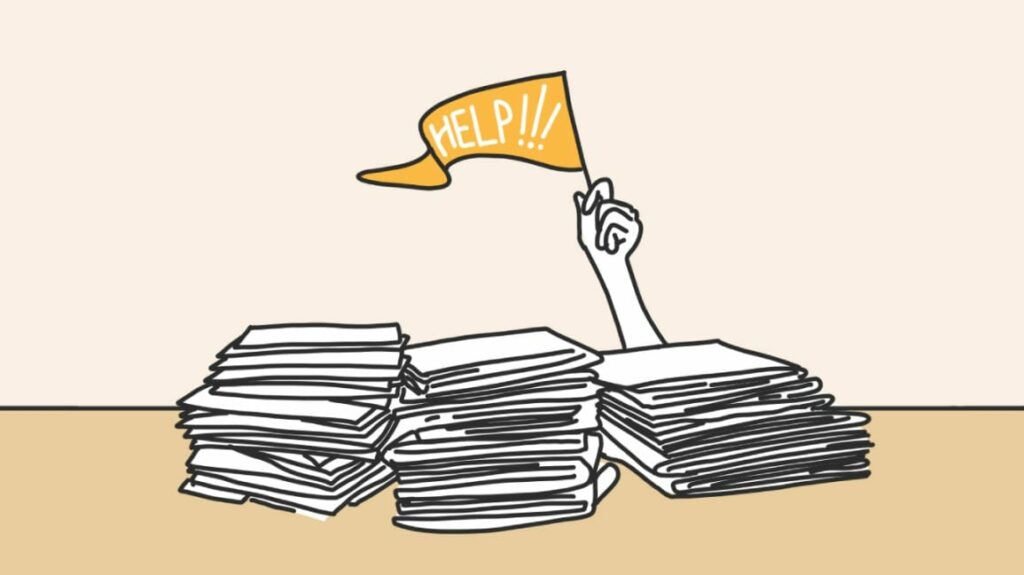
What is burnout?
Burnout was first described in 1974 by German-born American psychologist Herbert Freudenberger. Freudenberger described burnout syndrome as “becoming exhausted by making excessive demands on energy, strength, or resources in the workplace.”
Almost 45 years on since Freudenberger coined the term and research suggests that 23% of us are feeling burnt out at work very often or always, while another 44% are feeling burnt out at work sometimes. Given that almost 50% of us will struggle with burnout at least once in our career, why are we not taking it more seriously?
The early warning signs
According to Freudenberger’s original description, burnout is characterised by a mixture of physical symptoms and behavioural signs. Physical symptoms can show up as fatigue, shortness of breath, digestive issues and insomnia while behavioural signs may include frustration, anger, a suspicious attitude, cynicism and depression. Burnout’s long list of warning signs can explain why it is so difficult to spot because it can look very different from person-to-person. For example, for some people, it may come on more suddenly, in the form of a physical collapse or emotional breakdown. Whereas for others, it may build up over an extended period, showing up as long-term agitation, anxiety and an inability to cope.
Freudenberger went beyond simply describing the symptoms of the syndrome; he also described the personality traits that predispose someone to burnout and. He believed it was primarily “the dedicated and the committed” who are most likely to burnout. Or as a recent FT article phrased these individuals “insecure over-achievers.”

Thanks to the dawn of the smartphone, the geographical boundaries between work and home no longer apply, giving us remote access to our workload 24 hours a day, 7 days a week. And if you have a smartwatch then you may also be able to catch a glimpse of your work emails while you’re taking a class at the gym. On the one hand – literally in the case of the smartwatch! – this is amazing because these technological advancements- amongst other benefits- have enabled companies to offer employees more autonomy over their workload.
However, on the other hand, I wonder whether this non-stop, 24/7 culture makes the “dedicated and committed” workers described by Freudenberger more vulnerable than ever. Is this bigger, faster, stronger, harder mindset causing us to miss the early warning signs of burnout?
Normalising Stress
It’s become very easy for us to normalise feelings of stress and overwhelm. In fact, for many of us, it’s become a part of the daily narrative we share with our colleagues and friends. Perhaps you are someone who typically tells the “I’m so busy and stressed” story? And perhaps you are very busy and stressed. But do you ever stop to ask yourself why ‘busy and stressed’ has become a normal and culturally accepted part of life?
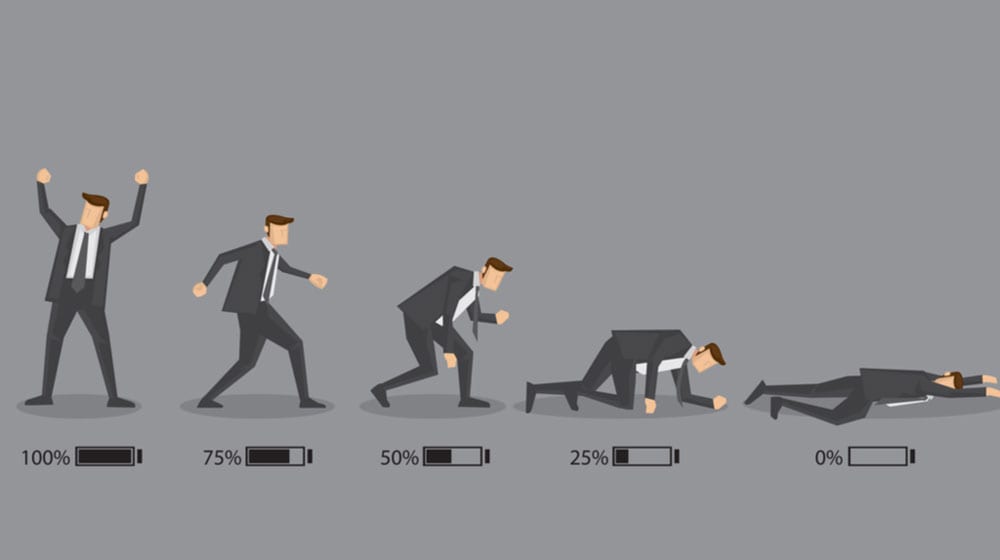
Five monkeys, a ladder, and a banana
In the influential ‘five monkeys’ experiment, a group of scientists placed 5 monkeys in a cage and in the middle, a ladder with bananas on the top. Every time a monkey went up the ladder, the scientists soaked the rest of the monkeys with cold water. After a while, every time a monkey went up the ladder, the others beat up the one on the ladder to avoid getting soaked. The scientists then decided to substitute one of the monkeys. Upon entering the cage, the new monkey immediately went up the ladder. Immediately the other monkeys beat him up. After several beatings, the new member learned not to climb the ladder even though he never knew why. After a while, a second monkey was substituted, and the same thing occurred. And the first monkey participated on beating up the second monkey, even though he’d never been sprayed with water. The same occurred when a third, fourth and fifth monkey was replaced. What was left was a group of 5 monkeys who- even though they had never been sprayed with water- continued to beat up any monkey who attempted to climb the ladder.
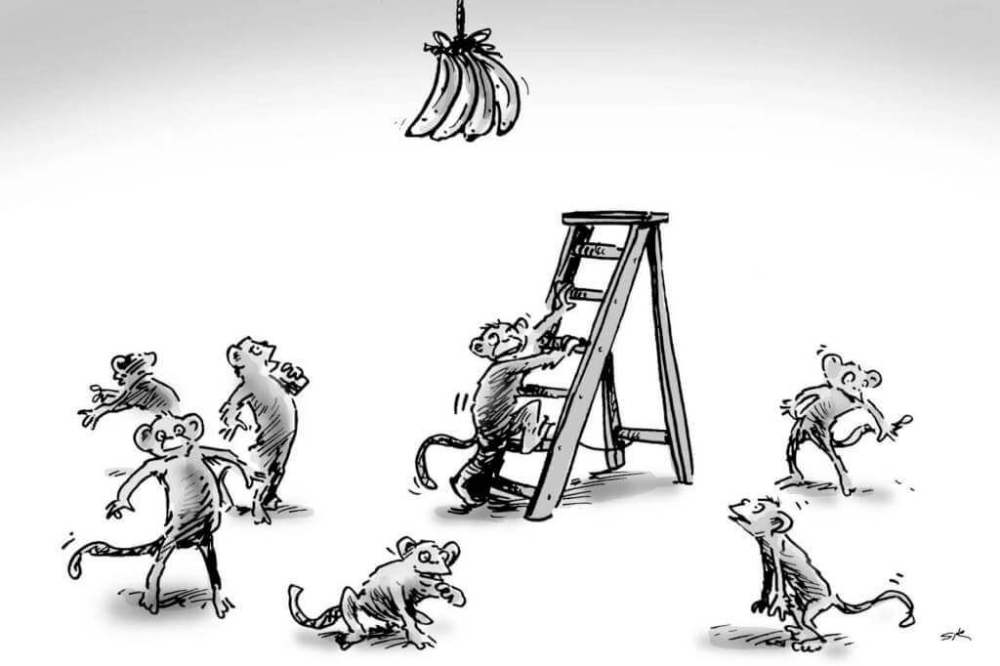
This is a great example of the way culture is created and why it perpetuates, even when it no longer makes sense. The experiment speaks to the phrase “that’s just how things are done around here.” When we get stuck in this fixed mindset, we lose sight of reasoning, stop questioning why things are the way they are and stop trying to change it.
In many work cultures the early warning signs of burnout- stress, fatigue, overwhelm and overwork- have become a part of the ‘that’s just what it’s like around here’ culture. We’ve normalised these important warning signs and as a result, we might be missing the early buildup of burnout. But we can’t spend our whole life living in the fast lane, always operating from a state of stress. Our bodies simply can’t handle being in ‘fight or flight’ mode for that long. And over time, if we don’t listen to the signals the body is sending us, the body burns out. This is its way of forcing us to finally listen to the signals we’ve been ignoring all along.
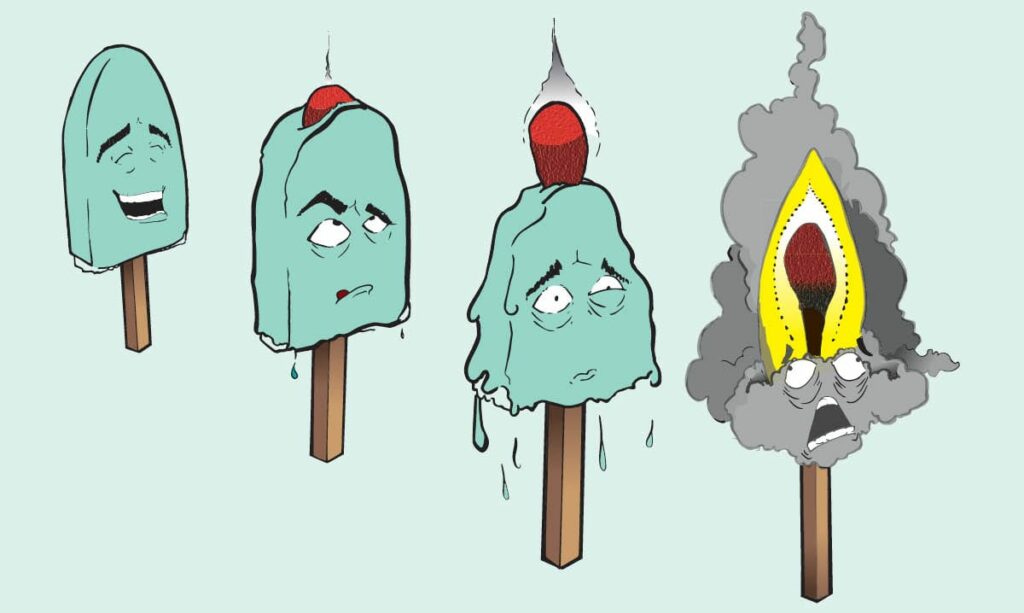
What we need to do about it?
As Heinemann & Heinemann point out in their 2017 research article: ‘Burnout Research: Emergence and Scientific Investigation of a Contested Diagnosis’
Freudenberger not only coined the term burnout, he also suggested preventive measures. “Because he believed that burnout is particularly linked to specific working environments and organisational contexts, he proposed intervening at an organisational rather than just an individual level. His recommendations included shorter working hours, regular job rotation, and frequent supervision and staff training.”
Freudenberger was certainly ahead of the curve. He recognised that burnout syndrome was much bigger than the individual it affects but a symptom of the culture he or she is working within. Which is why his advice for beating burnout is still very appropriate for employers and employees in the 21st century. We need to look- not only for the signs and signals of burnout in both ourselves and our colleagues- but also for the culture within which it perpetuates. Question yourself and others if you notice someone normalising stress. Create a dialogue about workload overwhelm. And start a conversation where it is okay not to be okay.
Model this value shift for your colleagues and you will help others to own where they are, get help when they need it and find a balance in life.
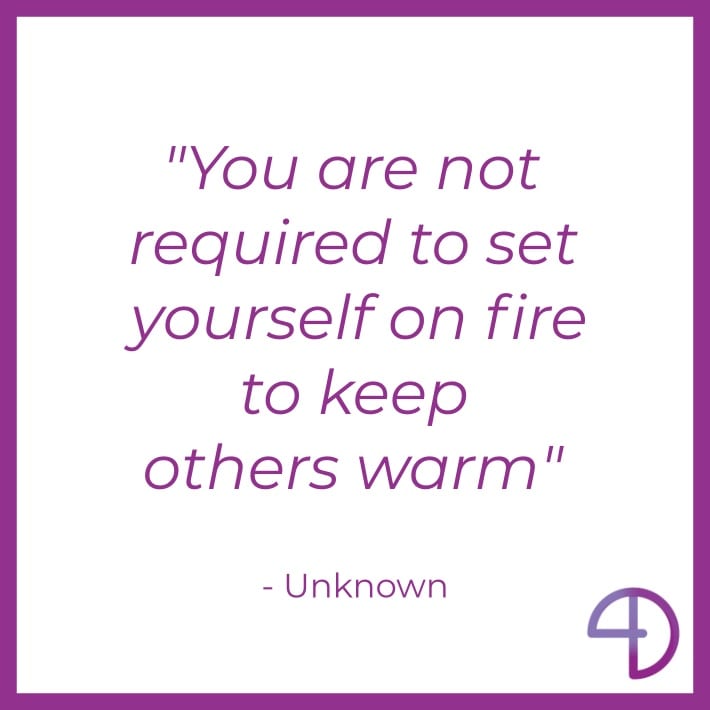
From Burnt Out to Fired Up
We urge you to go away and open up a dialogue around burnout in your workplace. If you think you’re too busy all the time, then maybe you are also too busy to be properly listening to the signs of burnout in your own life and noticing them in your colleagues and loved ones. To create space, start a conversation and step into a more self-compassionate way of relating to your workplace stress.


